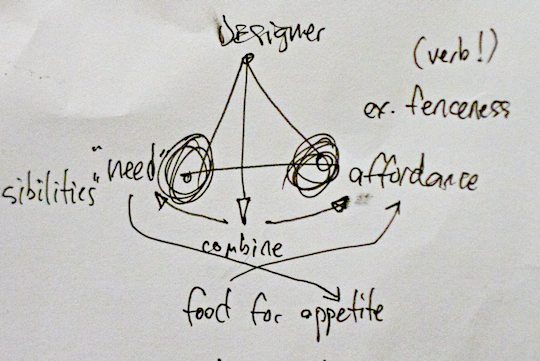Fourth Year First Day: A fourth year industrial design graduation project class at the Emily Carr University attempts to sort themselves into theme-based groups on the first day of their final meeting. (At this point the professors have already left the class in frustration).
Tom Becher flips over the course syllabus at his desk in the design studio and starts sketching on its back with a black pen: a triangle with three dots, some arrows, circles. He labels the top dot of the triangle ‘Designer,’ the left ‘Need’ and the right ‘Affordance.” Then he scribbles an energetic circle round and around the left dot, lowers his head and looks at Tobias and I over his glasses.
“You have demonstrated a lot of need,” he says about our design proposal. “You’ve got an entire suite of possibilities. What you need to do as a designer–” and here Becher makes a stroke descending from the Designer dot to the bottom of the triangle, continuing right on through before terminating it with a novelty-sized arrow, like a grandfather pendulum in need of a push–“is to start a fire with affordance. You need to start rubbing those two sticks together.”
At this point even more concentric and darkened circles are scratched around Affordance and a low arc with bi-directional arrows connects it, through the Designer stroke, to the Need dot.

My closest approximation of Becher’s diagram.
Becher draws this sketch on student notebooks, scraps of paper, white boards and blackboards a dozen times over the next three hours of one-on-one interviews. It’s the first day of the senior industrial design class and we’re both excited and confused.
Tobias, a communication design student, and I are collaborating on what will be a four month in-depth investigation into an area of design that is unique, of relevance to our education, and is interesting from both a professional and personal perspective. We’re all supposed to meet with Becher, or the course co-instructor Jim Budd, to get their perspective and guidance throughout the term. And while it’s hard to say just how much any of us parsed and processed out of Becher’s academic elongating this afternoon, the following Becher quotes and advice are at best insightful, poetic; at worst, entertaining.
Tom Becher quotes and advice. September 4, 2008
“All judgements are aesthetic.”
“Is there ever a time design isn’t about emotion?”
“Design is a process of accelerating your mistakes.”
You only know you’ve made mistakes if you evaluate your progress. How do you know? You need to ask if you met your goals.
Lifestyle design, experience design: what useless handles. Everything is lifestyle design, everything experience design.
Find [those problems/opportunities] where the hair stands up on the back of your neck.
A designer brings need and affordance together: two sticks rubbing to create a fire.
There is no such thing as a product design program. Designers just create artefacts. It’s how the consumer reads them that brings them into being.
Provocation and disruption; do these or it’s not going to be new.
Quick example: making this pen into a table leg design: Don’t just create the Philip Stark table leg, instead create the one table leg for this one table.
You are creating an exhibit/artefact.
[You have a] “suite of possibilities.”
Need and Affordance
Comments
3 Responses to “Need and Affordance”
-
Reading this gives me deja vu. I thought the Philip Stark pen table leg was all mine for sure.
-
It’s like he has his lexicon on a a roll-a-dex: “Hmm, what to say to frustratingly abstract students…bingo!”
-
Did you manage to sort yourself into groups?
Leave a Reply